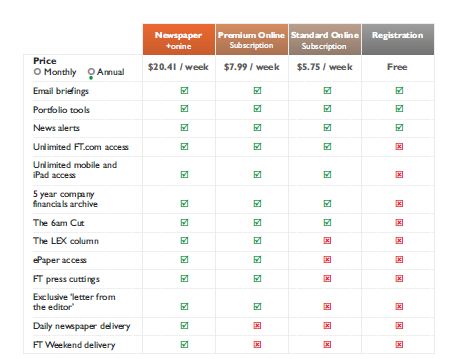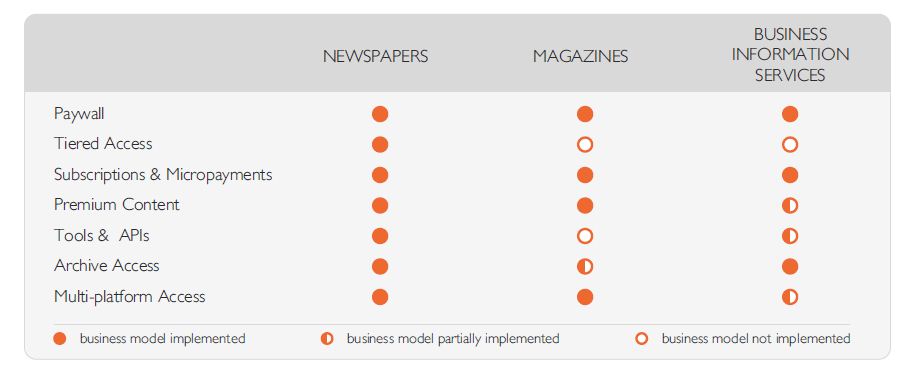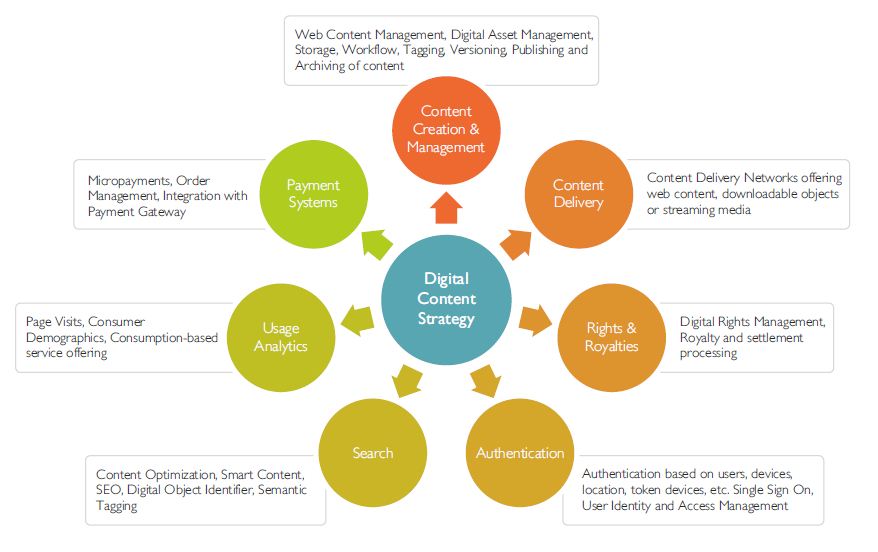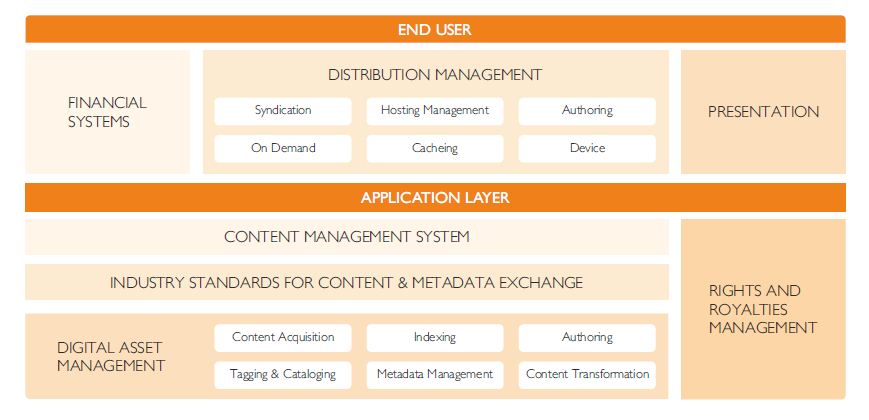Content Monetization Strategiesfor the Digital Publisher
The impact of commercial internet on media companies has been well documented – the internet allows faster and easier delivery of content while challenging and redefining traditional business models. The home entertainment, movies, publishing, music and television industries have all had to transform their business models and underlying operations to embrace the digital revolution. Publishers today have recognized the need to adopt and experiment with various content monetization models to make the most of their digital content. While content acquisition and distribution costs continue to rise and advertising revenues continue to dip, publishers are figuring out what their short and medium term strategies should be for generating revenue through digital content.
This white paper discusses opportunities for publishers in content monetization. It looks at current examples of monetized content in the publishing industry segments: newspaper publishing, periodical publishing, trade publishing, and business information services. It also discusses the technology architecture and components that publishers must invest in today – namely, digital asset management, web content management, authentication, micropayments, customer relationship management and usage analytics – in order to implement winning content monetization models.
Introduction
Traditional Approaches to Content Monetization and the Need for New Strategies
The Publishing industry has reinvented itself to adapt to the pervasiveness of the Internet and the possibilities it offers for easier and faster delivery of content. Over the past two decades publishers have utilized the Internet in two ways to monetize content. First, they have sold their content utilizing a direct-to-consumer model. Second, they have made the content freely available online depending upon advertising to achieve returns. The decision on which of these two models to use – or to apply some type of hybrid approach – is influenced by many factors such as the industry segment in which the publisher operates, the technology investments required to build content management and e-commerce systems, the need to ‘protect’ content once it is made available on the internet and the general conservatism towards new product development. Despite these factors, publishers were largely successful in monetizing their content so long as they had exclusivity over the content and the industry did not suffer from a significantly disruptive form of external competition.
However, over the past few years publishers have begun to realize that ‘traditional’ digital content monetization approaches are under pressure due to various economic, social and technological factors within and outside the publishing industry. For instance, during the economic recession of 2008-2009, the US newspaper industry alone lost US$3.1 billion in online advertising and has experienced flat or marginal growth in subsequent years. The magazine industry saw similar declines in ad 2 revenues during the economic downturn . The magazine industry is also seeing stiff competition from online aggregators such as Google that are eating into their pie of online advertising. Aggregators create value for their users by organizing content in useful ways and making it easily accessible. As a result, aggregators have become a very desirable alternative for advertisers. In fact, all of the prominent magazine companies representing hundreds of titles collectively generate almost the same amount from 3 advertising – approximately US$20 billion – as Google does on its own .
The publishing industry is at a stage where it is being forced to pursue new monetization models for its very survival.
Trends in Monetization
Today publishers have two huge advantages that they did not have a decade ago in getting consumers to pay for content. First, they have audiences that are far more technology savvy and accustomed to sophisticated websites with complex business models. These audiences are also familiar with content offerings from music and gaming industries that have been successful in monetizing their digital content. Publishers could learn a lesson from these industries.
Secondly, the tools and technology components such as web content management, digital asset management, authentication, digital rights management and usage analytics can streamline and improve the overall effectiveness of digital content creation and monetization processes.
In this section we look at some of the trends in content monetization and consider examples in three industry segments – newspaper publishing, magazine publishing and business information services. An analysis of these trends reveals interesting insights for content monetization in the publishing industry.
Newspaper Publishing
Newspapers have begun to adopt “paid content” models that charge consumers for access. A majority of newspapers carry what is known as a ‘digital edition’ of the newspaper on the website which resembles the look and feel of the print edition and has seen some success in getting subscribers to pay. The New York Times has met initial success with its pay wall and a metered access approach where visitors to the website are asked to pay to continue viewing after accessing a certain number of 4 articles . The paper recently announced that it had more than doubled the number of paid digital subscribers to about 250,000, and that overall, it had more than 1 million digital subscribers. This includes those paying for other editions, such as Kindle and print, who also get access to the website.
FT.com has erected a stricter pay wall where content is only available to registered users and subscribers. Free registered users can access up to 8 articles in a month and get access to tools such as news alerts. Paid subscribers get access to unlimited content and more online tools such as ePaper, mobile and iPad access
The Wall Street Journal went a step ahead and introduced micro-payments for individual articles and premium subscriptions to the Wall Street Journal long before many other newspapers in the industry followed suit.

Figure 1: FT.com’s free and subscription plans, and an indication of the four levels of engagement that it has with its users Source: FT.com.
Magazine Publishing
Magazines have always relied on advertising as the primary source of revenue. The online strategy has reflected this approach with content generally offered for free. However, as mentioned above, the online ad revenues are drying up and magazine publishers are rethinking their business models.
Some magazines that do not carry online advertising have adopted a pay wall and this has met with initial success. To encourage acceptance of a pay wall, companies like Atlantic Media, National Geographic, and Condé Nast are exploring models that offer a combination of their print content along with online perks and services like research and special access to events or product sales.
The advent of tablets has proven to be a tremendous opportunity for magazines. The rich color screen, interactivity and portability of the tablet is ideal to sell magazines. Initially, only single issues were offered at premium prices – a model that consumers soundly rejected. Readers balked at having to pay almost as much for a single digital issue as a year’s print subscription. As a result, publishers made very few sales and also gathered some ill will in the process.
But magazine publishers have applied the lessons learnt from early experiments and are enjoying greater success. Today, digital subscription options are available to consumers, and single issues have turned out to be a good way of selling back copies of magazines which has been cumbersome to do in print.
Business Information Services
In contrast to Magazine publishers, Business Information Services or B2B publishers have traditionally been subscription driven business models. However, the service offering in B2B markets is more than just content and includes large data-sets presented as infographics, custom reports, realtime information and analyst access which have their own challenges in monetizing and delivering content. The ongoing digital transformation in the industry and the challenging economic climate has changed the rules of engagement with consumers. In fact, consumers of these services are increasingly demanding information to be delivered online, bundled with other news, research, support and analysis tools. Many leading organizations such as Lexis Nexis are also integrating social networking and user generated content sites into their business models, both for lead generation as well as content development. Existing business models of business information service providers are also under tremendous pressure due to declining advertisement revenues, forcing them to focus more on subscription based business models. Due to this, publishing organizations are now adopting tiered subscription and pricing models focused on increasing revenues from existing clients rather than expanding their advertising and customer base.
Business Model Opportunities
Drawing from the emerging trends towards monetization, we take a look at the various components of online content business model opportunities and see how they can be combined into viable business models. Some of the key considerations for a digital publisher are:

Table 1: Publishing Segments and online content models Source: Wipro Technologies
The table shows the degree to which the three publishing segments are adopting the various business models discussed above. From this analysis, we can clearly see that newspapers have been most proactive in terms of experimenting with their existing business models
Technology and Architecture Components
The key for publishers to monetize their content is to experiment with different models and constantly evolve. The underlying technology architecture needs to be flexible as well as extensible, so that publishers do not need to invest in new technologies every time they need to experiment a new content offering. Only those publishers with the right architecture and technology solutions will be successful as both audiences and business models will change over time.
Technologies and Tools
In Figure 2, we identify the various technology components publishers need to adopt for a successful digital content strategy.
Reference Functional Architecture
A reference functional architecture such as the one depicted in figure 3 can be used to identify enterprise functions, interactions and the corresponding IT needs of a publisher. These functions can be used as reference by different domain experts to develop IT-systems as part of an informationdriven enterprise.

Figure 2 : Technology components modeled around the digital content strategy Source: Wipro Technologies

Figure 3: Reference Functional Architecture to support the digital content strategy Source: Wipro Technologies
Implementation Approach
In this section we discuss the implementation approaches that can enable a successful digital transformation to different content monetization models. While any approach should take into account the publisher’s industry, the technology components the publisher has already invested in and the strategic intent of the publisher to experiment with different models – discussing a generic implementation approach serves as a framework for reference. With its end-to-end capabilities across the stages, Wipro can play an important role as a consultant, design partner, vendor, system integrator and quality assurance provider through the implementation cycle.
The implementation approach is presented in four stages:
Stage 1 – Analysis
The publisher first needs to analyze the content creation process that is currently followed in the organization and performs an audit of the current technology components and architecture. It is important to formulate a vision for the content monetization model to be adopted so that the design and implementation follows smoothly.
Stage 2 – Design
In the design phase, the publisher does an information-modeling exercise on the current architecture – with or without the reference architecture – to arrive at the enterprise architecture required to support the vision that was formulated in Stage 1. The publisher should also define the metadata model for the content and any features or applications required.
Stage 3 – Selecting Tools & Technologies
An overview of the technologies required for a content strategy was presented in the previous section. The publisher selects the tools required and the respective suppliers for each of these technology areas. The publisher might also decide to choose a system integrator for implementation.
Stage 4 - Implementation
The tools and applications are built and integrated in the implementation stage and configured for the publisher. It is here where supporting tools such as payment gateways, analytics systems, authentication and access systems are also integrated. At this stage, the publisher will also have the opportunity to experiment with different content monetization models and adopt one or more models as desired.
Stage 1: Analysis
Stage 2: Design
Stage 3: Selecting Tools and Technology
Stage 4: Implement and Monetize
Conclusion
There is a pressing need for publishers to monetize their content assets by adopting new business models. The decline in advertising revenues, new competitive forces within and outside the publishing industry, changing consumer attitudes and digital transformation are all greatly influencing this transformation.
There are already different revenue and pricing models in use for monetizing digital content in the publishing industry segments of newspapers, magazines and trade publishing – some have already realized success. However, publishers must note that consumers are willing to pay for content not just when it is appealing, but they also require transparent pricing and billing models that are easily understood.
Many companies in the music, movies and gaming industries have been successful in monetizing their digital content and publishers could learn a lesson or two from these industries. Publishers have a variety of levers that can be employed to grow revenues in the digital world including a pay wall, single item sales, tiered access, extra content and archive access. After identifying the correct business model, publishers must next ensure they have the data tools and applications that will guarantee success. The key for publishers is to adopt more flexible approaches, experiment and evolve in order to win in the digital future.
Padmanabhan V is the Head of Media practice and consulting. He is responsible for building the practice focusing on Media and convergence addressing the entire media value chain from acquisition to delivery to monetization. In his current role he is responsible for developing content market place solution called COMET driving content monetization, recommendation and analytics and nScreen enabling delivery of content across multiple screens. He has governed and evangelized several transformation programs such as rights transformation, digital editorial platforms , mobility and market place across a broad spectrum of industries such as education , information services , broadcast , music & entertainment , publishing and convergence.
Sriharsha B V is a Sr. Business Analyst in the Media practice at Wipro. He has over 7 years of experience in the IT industry, the last 5 of which has been in media and publishing and casino gaming. Sriharsha is currently working as a Functional Lead for a leading publisher of scientific content and is based in Amsterdam. He holds a Bachelor’s degree in Electronics and Communication and a Post Graduate Diploma in Business Administration.